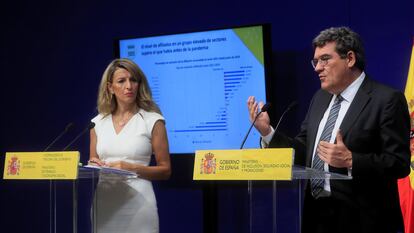Spain sees record fall in unemployment in June as fallout of pandemic eases
The lifting of coronavirus restrictions and the progress of the Covid-19 vaccination drive saw jobless numbers fall by nearly 167,000 last month, while 233,000 new jobs were created

The reactivation of the Spanish economy is progressing in step with the country’s Covid-19 vaccination campaign. The labor market is recovering from the impact of the coronavirus pandemic at an accelerating pace, setting new records in terms of the reduction of unemployment and unheard of job creation. In June, there were 3,614,339 people without jobs, 166,911 fewer than in May – that’s the biggest fall since the historical series began in 1996. The annual forecast is even better – there are 248,544 fewer people without jobs compared to the same month in 2020 (-6.43%), and once seasonal factors are accounted for, the fall in unemployment still comes in at a very respectable 102,604 people.
The rise in the number of people signed up to the Social Security system, considered a sign of job creation, completes this optimistic picture. In average terms and without removing seasonal factors, the system exceeded 19.5 million contributors on average in June, up 233,056 on the average for May (a rise of 1.21%). According to the data released on Friday by the Labor and Social Security ministries, all sectors improved their occupation levels, in particular the services sector, which rose 11.6% thanks to the lifting of most coronavirus restrictions back in May.
The arrival of the summer and the start of the tourist season have favored the recovery of the job market in Spain. The data in May had already pointed to a notable improvement – the number of unemployed fell by 129,378 people compared to April – and in June the curve has maintained that downward momentum.
“This is the most relevant data in the history of [Spanish] democracy,” proclaimed Labor Minister Yolanda Díaz. However, she went on to point out that the high number of unemployed is still a major matter of concern. “This structural unemployment does not incite any particular comfort, but the government is undertaking all of the necessary reforms to hastily address the disruption that the labor market has been having. The data have given us a bit of hope to keep working intensely,” she added.

The positive data confirm the forecasts from the government. Prime Minister Pedro Sánchez, of the Socialist Party (PSOE), recently stated that the executive forecast 18% growth in the year-on-year rate between April and June. “We are going to have unparalleled numbers in terms of economic growth this year and next,” Sánchez explained during an interview with radio station Cadena SER. Asked on Thursday about the forecast of reaching 19.5 million workers signed up with Social Security, the prime minister said that it was an important achievement “because in the previous crisis,” in reference to the 2008 global financial meltdown, “we took 10 years to return to previous levels [of employment].”
Meanwhile, Antonio Garamendi, the head of Spain’s biggest business association, the CEOE, recently predicted that there would be a “spectacular fall” during the summer of the number of workers who are still on the government’s ERTE furlough program. It should be pointed out that these employees, who have been sent home with pay due to the pandemic, do not count as unemployed in the government’s statistics.
A comparative look at the pre-pandemic situation shows the oxygenation of the labor market in Spain. In June 2019, there were 3,020,000 unemployed people in Spain, and a year later, after the first wave of Covid-19 had hit, the figure had risen to 3,860,000. This scenario worsened in February 2021, when the four-million barrier was broken. Since then, there have been falls as the intensity of the pandemic has subsided.
English version by Simon Hunter.
Tu suscripción se está usando en otro dispositivo
¿Quieres añadir otro usuario a tu suscripción?
Si continúas leyendo en este dispositivo, no se podrá leer en el otro.
FlechaTu suscripción se está usando en otro dispositivo y solo puedes acceder a EL PAÍS desde un dispositivo a la vez.
Si quieres compartir tu cuenta, cambia tu suscripción a la modalidad Premium, así podrás añadir otro usuario. Cada uno accederá con su propia cuenta de email, lo que os permitirá personalizar vuestra experiencia en EL PAÍS.
¿Tienes una suscripción de empresa? Accede aquí para contratar más cuentas.
En el caso de no saber quién está usando tu cuenta, te recomendamos cambiar tu contraseña aquí.
Si decides continuar compartiendo tu cuenta, este mensaje se mostrará en tu dispositivo y en el de la otra persona que está usando tu cuenta de forma indefinida, afectando a tu experiencia de lectura. Puedes consultar aquí los términos y condiciones de la suscripción digital.
More information
Últimas noticias
Most viewed
- Sinaloa Cartel war is taking its toll on Los Chapitos
- Oona Chaplin: ‘I told James Cameron that I was living in a treehouse and starting a permaculture project with a friend’
- Reinhard Genzel, Nobel laureate in physics: ‘One-minute videos will never give you the truth’
- Why the price of coffee has skyrocketed: from Brazilian plantations to specialty coffee houses
- Silver prices are going crazy: This is what’s fueling the rally











































